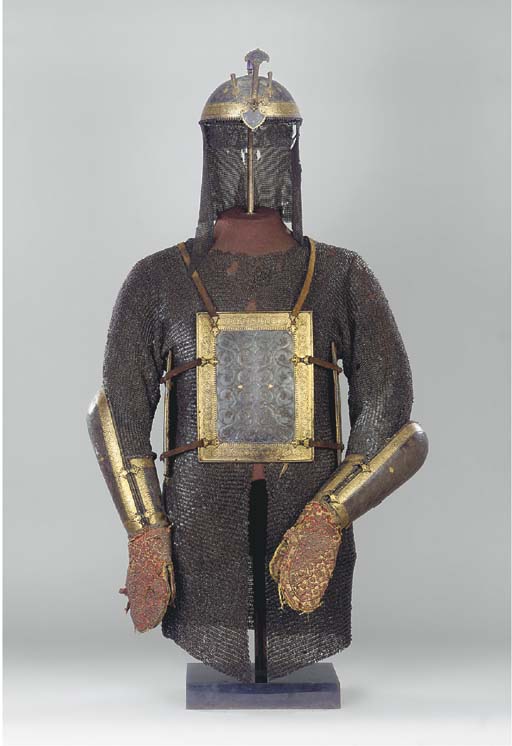
*A steel chilanum or long dagger, late 1500's*
Source:
http://www.christies.com/LotFinder/lfsearch/LotDescription.aspx?intObjectId=4893849
(downloaded Mar. 2007)
"A STEEL CHILANUM, INDIA, LATE 16TH CENTURY. The recurved double-edged tapering steel blade with grooves running the length of the blade, a pierced floral section above, the hilt of waisted form splayed below to meet the shaped collar, the centre rising to a ball finial, scrolling fingerguard with lotus bud terminal - 13 5/8in. (35cm.) long."

A suit of armor from the late 1700's
Source:
http://www.christies.com/LotFinder/search/LotDetail.asp?sid=&intObjectID=4351239&SE=CMWCAT03+1283823+%2D1427530013+&QR=M+1+59+Aqc0000900+1226800++Aqc0000900+&entry=india&SU=1&RQ=True&AN=60
(downloaded Sept. 2004)
"AN INDIAN CARVED AND GOLD DAMASCENED STEEL SUIT OF ARMOUR, NORTH INDIA, LATE 18TH CENTURY. Comprising a helmet (khula khud), mail coat with four solid plates (char-i aina) and two armguards (bazuband), the helmet of typical form with very finely worked mail veil, the surface engraved with scrolling tendrils issuing iris flowerheads, a band of fine gold damascened floral meander below, the char-i aina and bazubands decorated en suite, the bazubands also with cloth mittens originally covered with red velvet with a lattice design worked in brass rivets, damages to cloth and mail coat helmet 20in. (51cm.) high including veil."
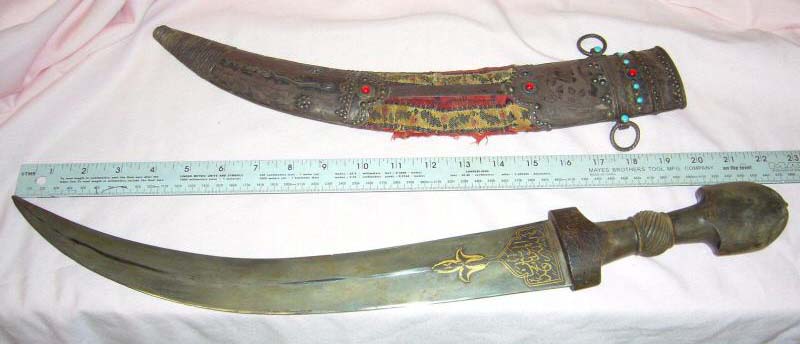
A curved dagger or khanjar, with its scabbard, c. late 1700's, exact provenance unknown; *detail one*; *detail 2*; *detail 3*; *detail 4*
Source: ebay, Jan. 2008
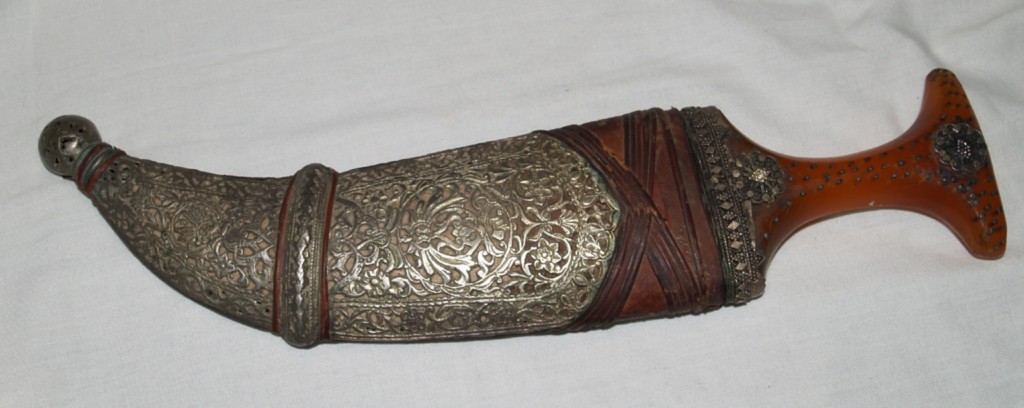
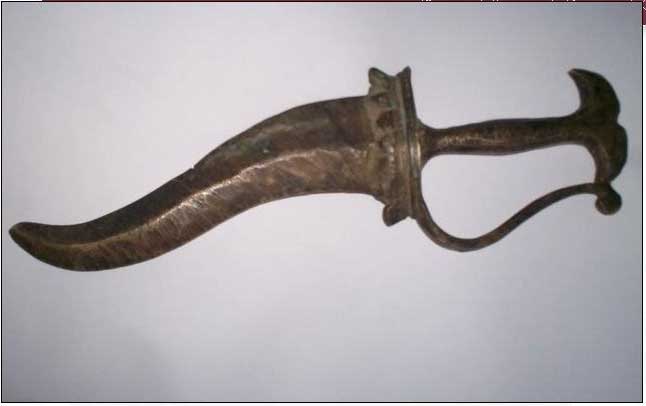
A curved dagger, or khanjar, about 11" long, made of a brass alloy; from Orissa, exact date unknown
Source: ebay, Feb. 2007
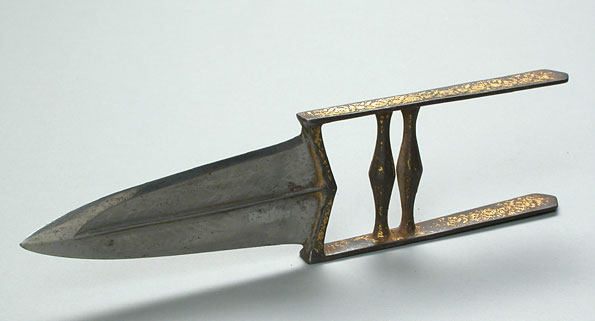
A steel dagger or katar, meant to be gripped at right angles to the blade for forceful stabbing; 1700's
Source: ebay, Dec. 2004
*A katar with extended arm-guards for protection; and a scabbard; 1700's*
Source:
http://www.christies.com/LotFinder/search/LOTDETAIL.ASP?sid=&intObjectID=4572705&SE=CMWCAT03+104305+%2D1629924794+&QR=M+1+0+Aqc0000900+91109++Aqc0000900+&entry=india&SU=1&SN=7074&RQ=True&AN=1
(downloaded Sept. 2005)
"A LARGE STEEL DAGGER (KATAR), India, 18th century. The curved blade of watered steel with damascened design of idiosyncratically drawn wild animals and huntsmen and with swollen tip, each side with groove running along the centre, one side retaining five freely moving ball bearings, the double grip and armguards adorned with damascened vegetal ornament and some wild animals, the steel scabbard similarly decorated, slight loss of gold overlay and slight corrosion in parts. 24¼in. (61.5cm.) long in scabbard."
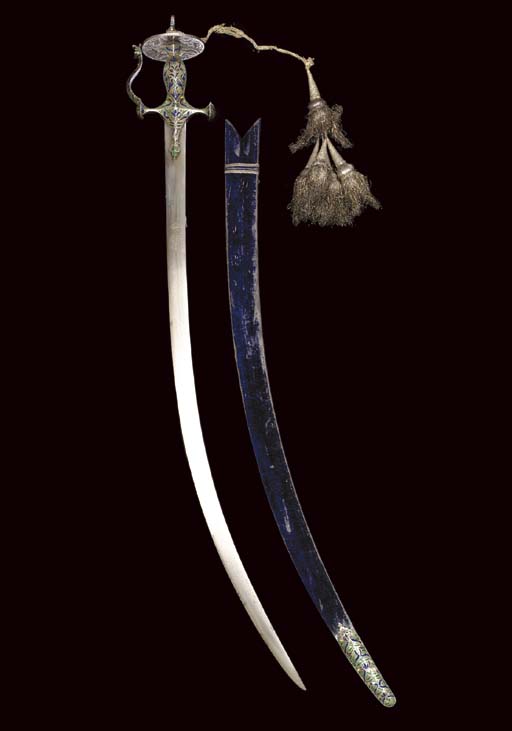
A late-Mughal sword, or talvar (also called a shamshir)
Source:
http://www.christies.com/LotFinder/search/LOTDETAIL.ASP?sid=&intObjectID=4572703&SE=CMWCAT03+104305+%2D1629924794+&QR=M+1+0+Aqc0000900+91109++Aqc0000900+&entry=india&SU=1&SN=7074&RQ=True&AN=1
(downloaded Sept. 2005)
"A MUGHAL SWORD (TULWAR) WITH ENAMELLED HILT AND CHAPE. Lucknow, India, late 18th century, the blade Iran, probably 17th century. The curved watered-steel single-edged blade with motto and maker's name inlaid in gold nasta'lia within cusped cartouches, the silver-gilt hilt with hand guard terminating in a dragon's head and disc pommel, decorated with champlevé translucent and opaque enamels in blue, green, yellow, orange and purple, with various birds amidst foliage, with original tassel, now separated, the original wooden scabbard covered in blue velvet, the chape decorated en suite with the hilt, slight loss of gold inlay on blade, also of enamel to the hilt and chape, velvet worn in places. 36in. (91.5cm.) long in scabbard.
Lot Notes: The best Indian swords often used Persian blades, and the present one is a very fine watered steel example from Isfahan, its quality suggesting a 17th century date of manufacture. It is inscribed with inlaid gold within two cusped panels, the upper one reading nasr min allah wa fatah qarib "Help from God and Victory is Close at Hand", whilst the lower one reads, in typical self-deprecating style 'amal kalb 'ali isfahani "work of the Dog of 'Ali at Isfahan." The maker's mark appears in a small square box to the top left of the upper cartouche, and reads va, ha, ba, ra. Another blade with the same signature and maker's mark is illustrated in Alain Jacob, Les armes blanches du monde islamique, Paris, 1985, p.160."

The iron head of a mace, another weapon of the period, c.1700's
Source:
http://www.christies.com/LotFinder/search/LotDetail.asp?sid=&intObjectID=4682013&SE=CMWCAT04+19719+%2D1963285561+&QR=M+1+29+Aqc0000900+16858++Aqc0000900+&entry=india&SU=1&RQ=True&AN=30
(downloaded Mar. 2006)
"An iron Head of a Mace. India, circa 18th century. The ball with pointed metal spikes protruding from the surface, encircled by an inscription overall. 10½ in. (26.5 cm.) high."
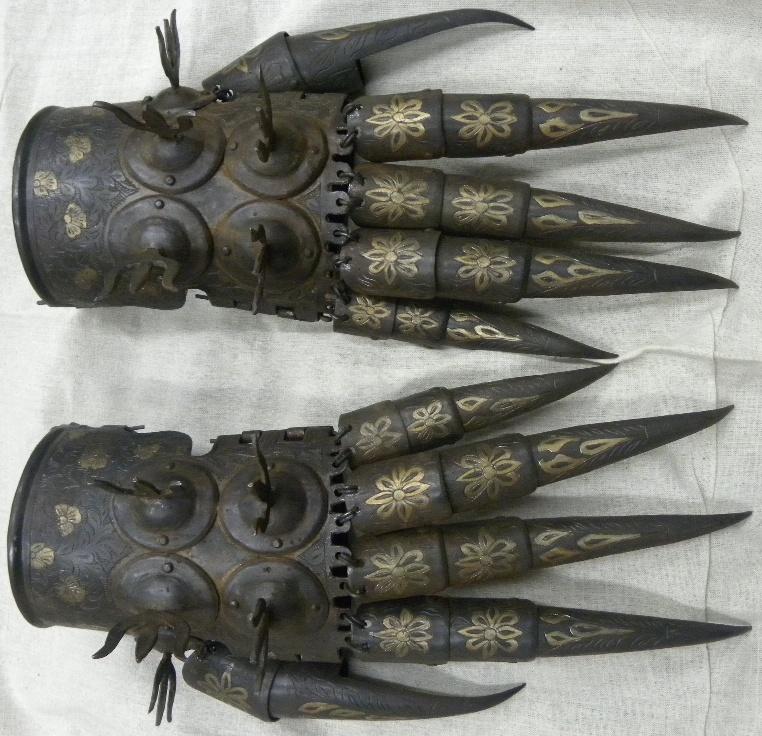
*A horn-mounted Khyber knife, 1700's*
Source:
http://www.christies.com/LotFinder/lfsearch/LotDescription.aspx?intObjectId=4893847
(downloaded Mar. 2007)
"A HORN MOUNTED KHYBER KNIFE, INDIA, 18TH CENTURY. The double edged tapering steel blade thickened on both sides, with horn handle with wood divide and lobed bronze attachment, the wooden sheath with metal end with dome finial, upper of black shagreen - length 16in. (40.5cm.)."
*A shamshir, Lucknow, early 1800's*
Source:
http://www.christies.com/LotFinder/lfsearch/LotDescription.aspx?intObjectId=4893832
(downloaded Mar. 2007)
"A LUCKNOW ENAMELLED SHAMSHIR, INDIA, EARLY 19TH CENTURY. With
single-edged watered steel blade inscribed near hilt, silver
fittings engraved with floral decoration, remains of green and
blue enamelling to the quillons and lion head terminal, the hilt
of ivory with cross-hatching and scabbard of shagreen - 36 1/4in.
(92cm.) long."

A battle axe, late 1800's
Source:
http://www.christies.com/LotFinder/lfsearch/LotDescription.aspx?intObjectId=4893837
(downloaded Mar. 2007)
"AN AXE WITH MOUNTED SHAGREEN HANDLE, INDIA, LATE 19TH CENTURY. With wide lunar shaped blade, tri-part back blade, and spear shaped top blade, the blades with etched decoration featuring wild animals and hunters, the shagreen handle shortened - 19 1/4in. (49cm.) long."
*A shield made of steel damascened in bronze, with embossed calligraphy; Agra, 1800's (diameter 9.1")*
Source: ebay, Apr. 2007
Source: ebay, Feb. 2008
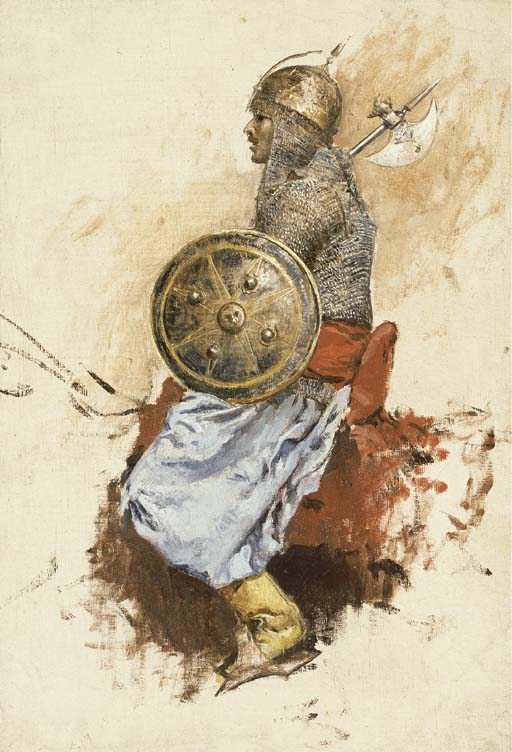
A study of a (recreated) Mughal horseman, by Edwin Lord Weeks, 1882
Source:
http://www.christies.com/LotFinder/search/LotDetail.asp?sid=&intObjectID=4693755&SE=CMWCAT04+15574+171833843+&QR=M+1+63+Aqc0000900+12321++Aqc0000900+&entry=india&SU=1&RQ=True&AN=64
(downloaded Apr. 2006)
"Edwin Lord Weeks (American, 1849-1903). Man in Armor (preparatory sketch for Entering the Mosque); oil on canvas, 18¼ x 12½ in. (46.4 x 31.8 cm.). Executed circa 1885.
Lot Notes This outstanding figure study of an armored Moghul horseman relates to a series of paintings of historical subjects, evocative of the 17th Century imperial Moghul court, which Edwin Lord Weeks executed between the mid-1880s and the mid-1890s. The present work was directly incorporated into a painting in which this figure appears as a mounted guard escorting a royal prince ascending the steps of a palace.
Indeed, this work is more than an 'oil sketch' in the conventional sense. The figure, so precisely detailed, is depicted astride a horse and rendered faithfully in handsome profile with his golden helmet, the chain mail vest, the magnificent damascened steel shield, down to the fancy boots and stirrups. Yet the work retains Weeks' characteristic balance between academic precision and painterly impression, as the entire figure is played against an abstract, flickering surface of brushwork. A few deft lines represent the profile of the horse's neck and back, while the lower area of russet, suggesting the flank of the horse, and the upper area of ochre, suggesting the plaster walls of the palace beyond, are simply treated as 'memories' of color and form for the artist's later reference in a full-scale painting.
The present work was executed in situ in India, and it is likely that the accoutrements it depicts were borrowed from the museums or archives of one of Weeks' Indian hosts and modeled for him on a contemporary figure."
*Two overview depictions by Albert Racinet, Paris, 1878*
Source: ebay, June 2007
== Indian Routes index == Indian Routes sitemap == Glossary == FWP's main page ==